We all know the saying that "dogs are man’s best friend”. While this is certainly true, it could also be said that they are, “Man’s oldest friend”. All dogs originate from a genetic lineage of Gray Wolves dating back nearly 15,000 years. It is likely that early humans would adopt orphaned wolf pups and then raise them to use as guards and hunters. Eventually, we began breeding them, selecting for specific traits that were desirable and deemed necessary. With over 340 dog breeds today many people wonder, what is the healthiest dog breed.
What Defines A Healthy Dog Breed?

In many cases, some of the healthiest dog breeds have what is known as ancestral hardiness. This is just a technical way of saying that they were bred over many generations to be healthy and tough. This is especially true in breeds that were developed by humans for a specific task such as herding sheep, pulling dog sleds, or retrieving hunted prey. These are commonly known as working dogs. On the other hand, breeds that were selected for companionship and love are known as companion dogs.
Common Signs Of A Healthy Dog
1) Fresh Breath
Bad breath can be a sign of poor gum hygiene.
2) Clean/Shiny Coat
Regular shedding and the production of natural oils are how your dog keeps a healthy coat.
Related Product: Mandarin Berry CBD Shampoo For Dogs (200mg)
3) A Healthy Weight That Is Consistent
Obesity is a serious problem now for pets. It can lead to all the same conditions and symptoms for dogs and humans. On the other hand, if your dog is losing an excessive amount of weight, it is likely a sign of a serious underlying condition.
4) Regular/healthy Urination Or Bowel Movements
Healthy bowel movements will not have mucus, blood, eggs, or worms. It will not have a chalky, white color or a tarry, black appearance. If your dog has transparent yellow urine, then their kidneys and bladder are probably healthy. On the other hand, if the urine is dark or even orange, it may be a symptom of gallbladder dysfunction, dehydration, and/or liver issues.
5) Active/Alert Demeanor
This is very easy to spot in your dog. It simply means that they have an ongoing interest in their environment and have a healthy amount of energy.
6) Clean Ears Without Odor
If there is excessive wax, liquid discharge, and/or an offensive odor, it may be a sign of an underlying health condition.
Ultimately, a healthy dog is a happy dog.
Browse our healthy CBD pet products here
Common Health Problems In Dogs
1) Arthritis
Arthritis in dogs is a chronic inflammation of joints throughout the body.
2) Skin Issues
There are a variety of reasons why your dog may have lesions (hot spots) or suffer from tender, red, scaly, and/or flaky skin, including allergies and/or parasites.
3) Ear Complications
These are very common in dogs. Ear complications usually relate to allergies as well as skin issues. There are also certain breeds that are predisposed to ear complications. For example, some breeds have floppy ears that easily trap moisture (this creates an ideal environment for bacteria to propagate).
4) Urinary Tract Issues
Many owners may mistake their dog’s urinary incontinence for behavioral issues. Common signs of a urinary tract issue include excessive/inappropriate urination, excessive thirst, and fatigue.
5) Vomiting/Diarrhea
These are generally the most common health problems in dogs. Either problem may be an underlying condition.
If bred properly, however, the dog will likely avoid these various conditions.
Pure Bred vs. Mixed Breeds

To put it in more general terms, a healthy dog breed is simply one that does not need constant and/or extensive veterinary treatment for any number of hereditary issues. Furthermore, there has been a prevalent piece of wisdom stating that mixed-breed dogs are always healthier and less susceptible to genetic problems than purebred dogs.
However, a 2013 study in the Journal of the American Veterinary Medical Association examined this claim with more than 27,000 patient cases and the 24 most common hereditary canine issues. The study concluded that of the 24 issues, 13 had no significant difference between the two groups. One issue was more prevalent in mixed-breed dogs, and 10 were more prevalent in purebred dogs.
Consequently, researchers and the American Kennel Club (AKC) state that if purebred dogs are not inbred by their breeders, then they can be just as healthy as any mixed-breed dog.
Furthermore, the AKC requires responsible breeders to conduct health clearances on all their breeding stock, including administering:
- An annual eye exam (CAER)
- A hearing test (BAER)
- Hip x-rays
- Patella (kneecap) certification
Top 12 Healthiest Dog Breeds
By monitoring their breeding stock and avoiding inbreeding, breeders can produce pure breeds that are incredibly healthy. Due to their hard work and diligence, the 12 dog healthiest dog breeds are:
1) Australian Cattle Dog
Known colloquially as “Aussies”, these are extremely hardy dogs, bred to withstand the difficulties of the Australian Outback. Some people refer to Australian Cattle Dogs as “heelers” for their tendency to nip at the heels of the animals they are herding. There is a famous case of an Aussie named Bluey. This Aussie was alive for an astonishing 29 years! However, they may suffer from deafness. Many believe this is the healthiest dog breed, but the other breeds on this list could easily take this title as well.
2) Border Collie
Border Collies, made famous by the character of Lassie, are one of the smartest dog breeds and are the very definition of a “working dog”. They have seemingly boundless stamina and unlimited energy, although they may develop eye problems and eventually go blind. This type of dog definitely is at the top of the competition for the healthiest dog breed.
3) Chihuahua

These Chihuahua tiny companion dogs may seem fragile and delicate, but they are actually extremely healthy! They are the smallest official breed according to the AKC, weighing only between 2 to 6 pounds. They may suffer from diseases usually associated with smaller breeds, including dental issues. Chihuahuas might just be the healthiest dog breed, while they're certainly the tiniest.
4) Bichon Frise
These small, fluffy-looking dogs are excellent family pets that do well with children and/or other dogs. They have an average lifespan of up to 15 years, though they may suffer from allergies.
5) Belgian Malinois/German Shepherd
Although these are technically two separate breeds, they are so closely related that they can be grouped together. These are famous working breeds that are an important part of law enforcement and search and rescue (SAR), although they both may suffer from hip problems.
6) Standard Poodle

This breed may look funny and silly with their outrageous haircuts and grooming, but they are actually tough animals that are robust and healthy. However, they do have a predisposition to various types of detrimental conditions.
7) Greyhound/Whippet
Again, these are two separate breeds that are very closely related. A greyhound is simply the full-size version, whereas whippets are smaller (they are Italian Greyhounds). Contrary to popular belief, these breeds are not hyperactive and do not need large living space. They adapt very well to small apartments and are easy to crate train.
8) Beagle
This breed is a well-rounded dog that was bred for hunting, making them extremely agile and possessing an excellent sense of smell. Consequently, you will see them as a bomb- or drug-sniffing dog. They are also notorious escape artists and generally need to be in a pack of at least two or more.
9) Shiba Inu

People describe these dogs as adventurous, tough, and extremely agile; they also perform exceptionally well outdoors. They are also incredibly popular online and are the subject of the incredibly prevalent “Doge meme”.
10) Havanese
These small, fluffy dogs are prime social animals and integrate perfectly into a family with children. They love for people to hold them and crave affection and/or attention from their owners. They are, however, prone to deafness, and/or heart murmurs.
11) Husky/Malamute
These two breeds are also closely related. They both were bred to pull sleds in the Alaskan, Canadian, or the Siberian Arctic. These are extremely high-energy breeds that need to be constantly stimulated with tasks. They also crave a strict hierarchy while living within a pack.
12) Corgi
These stout, short dogs are surprisingly quick and agile despite their short legs. They were bred as herding dogs, particularly for cattle and sheep. Much like the Shiba Inu, Corgis are exceptionally popular online.
Related Post: How Many Dog Breeds Are There?
Final Thoughts - Top Healthiest Dog Breed
We all know that dogs enrich our lives, bringing us endless joy and happiness. Because of the long history we share with these beloved animals, they have evolved alongside us. Consequently, many of these breeds can be preserved if they are bred responsibly and given enough genetic variation to avoid these hereditary problems. Feel free to check out more of our website here or learn about all the different dog breeds here.







![Probiotics For Dogs [Soft Chews] - HolistaPet](http://www.holistapet.com/cdn/shop/files/Probiotic-Infographic-1_472d7a29-e30c-435a-9638-1365d8c3a9f9.jpg?v=1725384841&width=104)
















![English Springer Spaniel [Get To Know This Lively & Sweet Dog Breed]](http://www.holistapet.com/cdn/shop/articles/159_87765f4d-e64d-4eb8-a81f-dc52fe0b92e9.jpg?v=1738275849&width=500)









Leave a comment
All comments are moderated before being published.
This site is protected by hCaptcha and the hCaptcha Privacy Policy and Terms of Service apply.